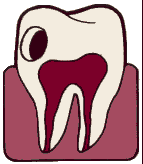| Tooth Decay |

What is Tooth Decay?
Tooth decay, also called ‘dental caries’ or simply ‘cavities’, is one of the most common human diseases and one of the main causes of tooth loss. Tooth decay is a condition characterized by the progressive destruction of the tooth structure due to the loss of minerals from the calcified tissues (enamel, dentin) that form the tooth. It has been estimated that 90% of the population have at least one cavity. It is second in prevalence only to the common cold.
Causes of Tooth Decay
The main causes of tooth decay are parts of a dangerous triangle formed by dental bacterial plaque, sugar and acids. Poor oral hygiene in combination with a diet rich in sugars are the basic factors contributing in developing tooth decay.
If the bacteria are not removed from the mouth with regular tooth brushing and flossing, they form dental plaque and dental calculus, and start to metabolize the sugars of foods/drinks into acids. These acids cause the progressive breakdown of the tooth enamel leading to the formation of dental cavities.
Several systemic, genetic, environmental or behavioral risk factors may increase significantly the risk of dental caries.
Symptoms of Tooth Decay
Most patients recognise the symptoms of tooth decay only in the advanced stages of the disease. A toothache is the most common symptom when the damage has reached to the live part of the tooth. But some early signs can help to detect possible areas of decay and treat them before they become dental cavities and cause significant damage to our teeth.
Stages of Tooth Decay
In the early stages of tooth decay (white spot on enamel) the condition is reversible without causing permanent damage to the tooth. In a later stage the decay breaks through the enamel creating a hole in the tooth (cavity). In advanced stages, the tooth structure is irreversibly damaged and a tooth abscess may be formed, requiring dental restoration or/and endodontic therapy to avoid tooth loss.
Dignosis of Tooth Decay
Early diagnosis of tooth decay can help to prevent the need of expensive dental treatments. Regular dental visits are the key to early diagnose cavities and other dental problems. New techniques have been developed in the recent years to help spot and treat areas of enamel demineralization before a cavity is formed.
Tooth Decay Prevention
The control of dental plaque bacteria in the mouth is the key factor in tooth decay prevention. Proper daily oral hygiene, flossing and brushing teeth after every meal with a fluoride toothpaste, regular visits to the dentist, and a healthy diet low in sugars can help maintain good dental health and prevent cavities.
The use of dental sealants can also help to prevent cavities, especially in children.
Treatment of Tooth Decay | Dental Restorations
Tooth decay is a condition that, unless it is diagnosed and treated in the very early stages, causes the destruction of the tooth structures. For this reason dental restoration is usually required for the treatment of tooth decay after the decayed tissues have been removed by the dentist:
- Dental fillings are the most common tooth restorations made of amalgam, gold or composite resin used to treat a dental cavity
- Inlays – Onlays are indirect dental restorations made of porcelain providing better esthetic results and strength
- Dental crowns (caps) made of gold or porcelain are used when tooth decay has caused extensive tooth damage
If tooth decay has reached and infected the pulp and a tooth abscess is formed, endodontic treatment (also known as root canal therapy) is required to treat the tooth infection before the tooth restored. When the tooth is too damaged to be restored or when the tooth infection can not be eliminated even after a root canal, a tooth extraction may be the only option.
Dentists recommend that every tooth lost due to tooth decay or any other reason should be replaced as soon as possible to prevent further damage.
- Dental bridges
- Partial or full dentures
- Dental implants - The best solution is to replace missing teeth with dental implants which provide the most reliable, functional and esthetic results.
- Dental Plaque
- Dental Calculus
- Gum Disease
- Tooth Decay
- Tooth Abscess
- Toothache
- Tooth Loss
Related Problems
- Root Canal Therapy
- Dental Restoration
- Dental Fillings
- Inlays -Onlays
- Dental Crowns
- Dental Bridges
- Dentures
- Dental Implants
articles about
Tooth Restoration
